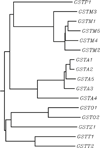Analysis of the glutathione S-transferase (GST) gene family
- PMID: 15607001
- PMCID: PMC3500200
- DOI: 10.1186/1479-7364-1-6-460
Analysis of the glutathione S-transferase (GST) gene family
Abstract
The glutathione S-transferase (GST) gene family encodes genes that are critical for certain life processes, as well as for detoxication and toxification mechanisms, via conjugation of reduced glutathione (GSH) with numerous substrates such as pharmaceuticals and environmental pollutants. The GST genes are upregulated in response to oxidative stress and are inexplicably overexpressed in many tumours, leading to problems during cancer chemotherapy. An analysis of the GST gene family in the Human Genome Organization-sponsored Human Gene Nomenclature Committee database showed 21 putatively functional genes. Upon closer examination, however, GST-kappa 1 (GSTK1), prostaglandin E synthase (PTGES) and three microsomal GSTs (MGST1, MGST2, MGST3) were determined as encoding membrane-bound enzymes having GST-like activity, but these genes are not evolutionarily related to the GST gene family. It is concluded that the complete GST gene family comprises 16 genes in six subfamilies--alpha (GSTA), mu (GSTM), omega (GSTO), pi (GSTP), theta (GSTT) and zeta (GSTZ).
Figures


References
Publication types
MeSH terms
Substances
Grants and funding
LinkOut - more resources
Full Text Sources
Other Literature Sources
Molecular Biology Databases
Research Materials
Miscellaneous

